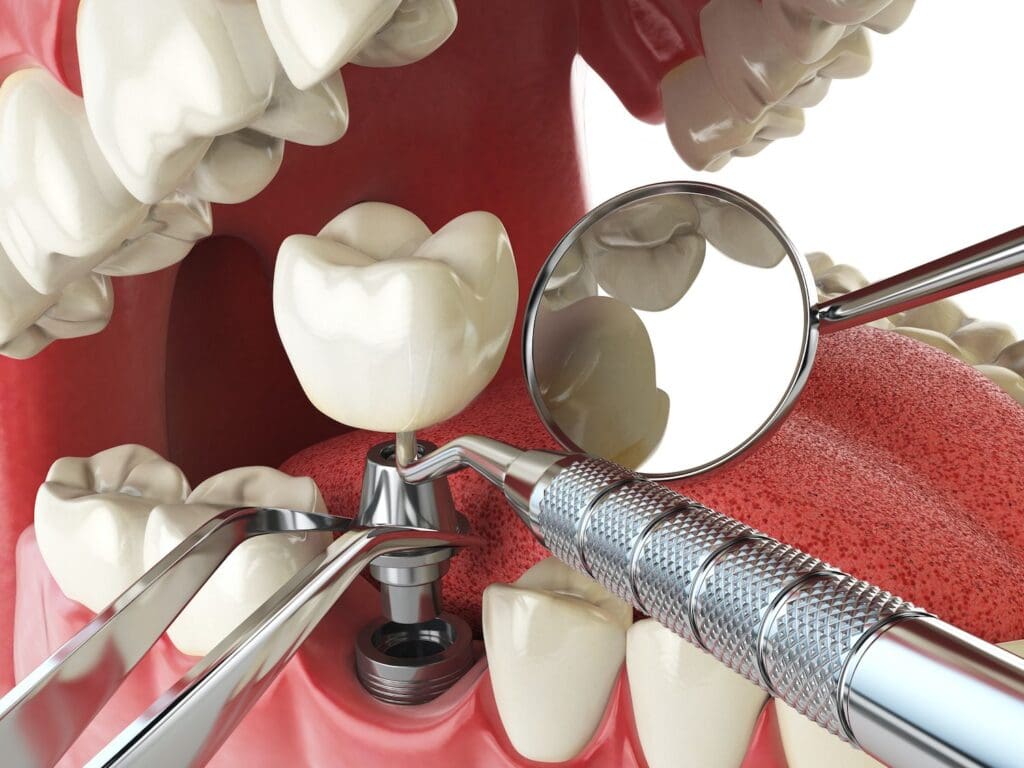A single missing tooth can compromise the structure and health of your entire smile.
Even one missing tooth jeopardizes the health and stability of your bite. Replacing a single missing tooth can prevent a whole range of secondary dental health concerns from developing.
A single missing tooth increases your risk of:
- Shifting of teeth, crooked teeth
- Additional tooth loss
- Bone loss
- Gum disease
- Tooth decay

Solutions: Replace a Missing Tooth
Dental implants are the “gold standard” in single-tooth replacement. Designed to function and look like a natural human tooth, a single dental implant is the most effective way to replace a missing tooth.
Learn more about dental implants:
-
- Dental Implants Overview
- Benefits of Dental Implants
- Implant Supported Dentures
- All-on-Four Implants
How is a Single-Tooth Implant Procedure Performed?
A single implant is composed of three essential pieces that mimic the natural ingenuity of a tooth. The full dental implant consists of a dental implant post, an abutment, and a dental crown. Each piece works together to create a secure, permanent, and comfortable replacement option that improves the look and health of the smile.
- The Dental Implant Post: The implant post is a small titanium screw-like structure that is surgically implanted into the jaw. The implant post acts as a prosthetic root system, helping to stabilize and stimulate natural bone growth. The implant is made of medical-grade titanium that fuses with the jaw bone, helping to prevent shifting of the teeth or additional bone or tooth loss from occurring. Once the implant is inserted into the root socket, it is left to heal for approximately 3-6 months.
- The Abutment: A small metal abutment is then attached to the top of the implant post and protrudes from the gum line. The abutment is used as an anchor to hold a dental crown in place.
- The Dental Restoration: A dental crown will be custom-designed to blend seamlessly with adjacent teeth. Dental crowns are designed using high-quality modern dental materials that reflect light like natural teeth. The crown is color-matched and shaped to enhance your natural smile.
Is a single-tooth implant the right solution for me?
Dr. Cavallo believes dental implants to be far and away the best solution for a missing tooth or a tooth needing extraction. It can be tempting for a patient not to replace a missing tooth, but this shortsighted cost savings can be an expensive long-term decision.
Teeth remain in place through the pressure exerted upon them by the teeth on each side of them. When a tooth is missing, the teeth on each side of the gap tend to slide over into the gap. For a visual metaphor of sorts, think of it as similar to crowds in bleacher seats at a football game. When a person leaves to get a hot dog, the people slide over into the gap. When your tooth alignment is involved, this can create issues with your bite alignment, leading to bruxism, temporomandibular joint pain, and other problems.
Dental implants feel and function just like a natural tooth. They allow you to eat anything you want, and they typically last the remainder of your life. Cosmetically, they return your complete smile, and they maintain the proper alignment of your teeth.
Of the two options for replacing a missing tooth — an implant or a bridge — a dental implant is the way to go.
How long does it take a single-tooth implant to heal?
The process of receiving a single implant involves three steps, as described elsewhere on this page. Once Dr. Cavallo places the implant base into your jaw, it takes from 3-6 months (depending on the location and on the patient’s rate of bone growth) for the jawbone to grow around the implant and make it a part of the jaw. Healing for the small gum incision needed to access the jawbone takes just a week or so to heal.
Attaching the abutment/post to the implant base involves a second small incision to access the top of the implant base and attach the abutment. After this step, the gums need to heal and settle down around the abutment. This takes two weeks or so.
There isn’t any healing or time involved after Dr. Cavallo places the artificial tooth/crown onto the abutment. You can immediately begin using your new dental implant.
How long will a single-tooth implant last?
Dr. Cavallo prefers to use dental-grade porcelain for all of the crowns we place with dental implants. Dental porcelain closely resembles the slight translucence of natural tooth enamel in the way it absorbs some light and reflects some light. Dental porcelain is also virtually impervious to staining, and it is immensely strong.
In most cases, a single-tooth dental implant will last the remainder of the patient’s life. The implant base is not a question; it’s there for the duration once established. If something happens to the artificial tooth, it is easy to replace and attach to the implant base and abutment.
Are there any food restrictions with a single dental implant?
Unlike bridges, the alternative for replacing a single tooth, which requires the patient to avoid overly sticky or hard foods when chewing on their bridge, dental implants don’t require any food restrictions. You can eat anything you like, just as if your implant was a natural tooth.
During the process of placing your implant, you’ll have a couple of brief periods where small incisions in your gums need to heal, so you’ll eat some soft foods during the initial healing, but those are only temporary restrictions.
What type of anesthesia is used when placing a dental implant?
Dr. Cavallo uses local anesthetic for these procedures. If the patient chooses, they can add sedation to the procedure for added relaxation. But these are not painful procedures.
How do I care for my single-tooth implant?
Caring for a dental implant is no different than caring for your natural teeth — brush for two minutes twice daily and floss once.
What are the alternatives to having a dental implant?
Dental implants are the superior method for replacing a missing tooth because they function just like a natural tooth and last for decades. The only other option to replace a missing tooth or two is a dental bridge. Bridges have crowns on the natural teeth on both sides of the missing tooth.
The crowns are attached to an underlying metal structure with a porcelain artificial tooth fused to the metal. Resin surrounds the tooth to resemble gum tissue. If you’re missing multiple teeth, bridges are a more affordable option compared with a series of dental implants. Bridges do not have the same durability as implants.
